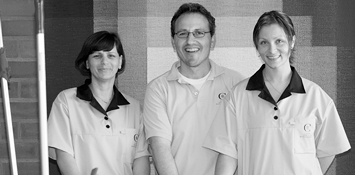
Cleaning buildings to a pan-Nordic standard
An advertising slogan used for pain-killers goes like this: ‘when you know where it hurts, why treat your whole body?’ The same principle is now being increasingly applied in the cleaning sector. When you know where the dirt is, why clean the whole building?
Even today, many cleaning tenders focus on cleaning frequency, methods and the equipment to be used rather than the desired results.
“The problem with this traditional type of tendering is that it doesn’t always consider what you actually get from your cleaning services. It says that you want cleaning, but not how clean you want it,” points out Fredrik Sandquist, Services Development Manager at Coor.
The Nordic markets have been utilising a single standard called INSTA 800 for the past ten years. In Sweden, the standard is designated SS 627801:2006, while in Norway and Denmark, it’s called NS-INSTA 800 and DS-INSTA 800 respectively. In Sweden, the standard is well proliferated, primarily in the public sector, but now, the private sector is taking a greater interest.
What does this new cleaning standard mean?
INSTA 800 can be used in all types of premises and building. Briefly, it is based on the client setting standards for how clean each separate area or item should be and how often the provider must monitor that the agreed quality standard is satisfied. Then, using the standard’s measurement systems and control processes, these clear quality standards can be monitored objectively.
“The client buys cleanliness, not cleaning sessions. Clearly, an operating theatre must have the highest possible cleanliness, whereas the cleanliness standards for storage and staircases are less stringent. The standard provides the necessary instruments for the customer to set clear expectations for cleaning quality, offering more assurance for all parties involved,” continues Fredrik.
Coor has worked actively on the standard since its introduction, and has substantial experience of exploiting its benefits and dealing with the challenges it brings.
“The greatest benefits of the standard are that it states clear, objective expectations of the quality to be achieved, but also that as a rule, it’s more cost-efficient and environmental than controlling cleaning frequencies. Customers only pay for what they need, while the requirement for energy usage, cleaning agents and consumables reduces,” explains Fredrik.
Are there any problems?
But there are challenges—the greatest being to get the market players to trust the standard completely and simultaneously apply it intelligently so they avoid excessive administration. Accordingly, Coor is in continuous dialogue with each customer on how to apply the standard on the relevant service provision, and work actively to ensure that staff, on-site with the client and where the services are provided, get the necessary training.
“We’re noting greater interest in the standard and its benefits in new tenders, and from existing customers. The quality, environmental and financial benefits are self-evident,” adds Fredrik.
To find out more:
Contact Sven-Erik Björkholm, Services Developer at Coor in Cleaning Services, sven-erik.björkholm@coor.com or phone: +46 (0)8 553 96153.
